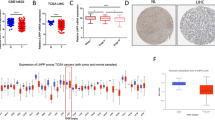Abstract
Hepatocellular carcinoma (HCC) is a malignant tumor driven by complex pathological mechanisms and is characterized by fast progression and poor prognosis. The main cause of death in HCC patients is tumor metastasis. However, underlying molecular mechanisms of metastasis are largely unknown in HCC. In the present study, a novel metastasis-related gene, leucine-rich-alpha-2-glycoprotein 1 (LRG1), was identified in HCC. We revealed that LRG1 expression was downregulated in HCC tissues by quantitative real-time PCR and immunohistochemical staining. In vitro assays demonstrated LRG1 had no effect on cell proliferation. Migratory and invasive potential of HCC cells was reduced by ectopic overexpression of LRG1, whereas silencing LRG1 could enhance migration and invasion of HCC cells. Furthermore, exogenous recombinant human protein of LRG1 could inhibit migration and invasion of HCC cells in vitro. The above findings indicate that LGR1 is involved in the inhibition of HCC metastasis and it may function as a novel metastasis suppressor in HCC.






Similar content being viewed by others

Abbreviations
- HCC:
-
Hepatocellular carcinoma
- LRG1:
-
Leucine-rich-alpha-2-glycoprotein 1
- LRR:
-
Leucine-rich repeat
- CRP:
-
C-reaction protein
- TMA:
-
Tissue microarray
- DMEM:
-
Dulbecco’s modified Eagle medium
- FBS:
-
Fetal bovine serum
- GAPDH:
-
Glyceraldehyde-3-phosphate dehydrogenase
- CCK-8:
-
Cell Count Kit-8
- PBS:
-
Phosphate-buffered saline
References
Jemal A, Bray F, Center MM, Ferlay J, Ward E, Forman D. Global cancer statistics. CA Cancer J Clin. 2011;61(2):69–90. doi:10.3322/caac.20107.
Perz JF, Armstrong GL, Farrington LA, Hutin YJ, Bell BP. The contributions of hepatitis B virus and hepatitis C virus infections to cirrhosis and primary liver cancer worldwide. J Hepatol. 2006;45(4):529–38. doi:10.1016/j.jhep.2006.05.013.
Zhong JH, Ma L, Li LQ. Postoperative therapy options for hepatocellular carcinoma. Scand J Gastroenterol. 2014;49(6):649–61. doi:10.3109/00365521.2014.905626.
Aravalli RN, Steer CJ, Cressman EN. Molecular mechanisms of hepatocellular carcinoma. Hepatology. 2008;48(6):2047–63. doi:10.1002/hep.22580.
Forner A, Llovet JM, Bruix J. Hepatocellular carcinoma. Lancet. 2012;379(9822):1245–55. doi:10.1016/s0140-6736(11)61347-0.
Haupt H, Baudner S. [Isolation and characterization of an unknown, leucine-rich 3.1-S-alpha2-glycoprotein from human serum (author’s transl)]. Hoppe-Seyler’s Zeitschrift fur physiologische Chemie. 1977;358(6):639–46.
Takahashi N, Takahashi Y, Putnam FW. Periodicity of leucine and tandem repetition of a 24-amino acid segment in the primary structure of leucine-rich alpha 2-glycoprotein of human serum. Proc Natl Acad Sci USA. 1985;82(7):1906–10.
Kobe B, Kajava AV. The leucine-rich repeat as a protein recognition motif. Curr Opin Struct Biol. 2001;11(6):725–32.
Kobe B, Deisenhofer J. Proteins with leucine-rich repeats. Curr Opin Struct Biol. 1995;5(3):409–16.
O’Donnell LC, Druhan LJ, Avalos BR. Molecular characterization and expression analysis of leucine-rich alpha2-glycoprotein, a novel marker of granulocytic differentiation. J Leukoc Biol. 2002;72(3):478–85.
Wang X, Abraham S, McKenzie JA, Jeffs N, Swire M, Tripathi VB, et al. LRG1 promotes angiogenesis by modulating endothelial TGF-beta signalling. Nature. 2013;499(7458):306–11. doi:10.1038/nature12345.
Kentsis A, Ahmed S, Kurek K, Brennan E, Bradwin G, Steen H, et al. Detection and diagnostic value of urine leucine-rich alpha-2-glycoprotein in children with suspected acute appendicitis. Ann Emerg Med. 2012;60(1):78–83. doi:10.1016/j.annemergmed.2011.12.015 e1.
Serada S, Fujimoto M, Terabe F, Iijima H, Shinzaki S, Matsuzaki S, et al. Serum leucine-rich alpha-2 glycoprotein is a disease activity biomarker in ulcerative colitis. Inflamm Bowel Dis. 2012;18(11):2169–79. doi:10.1002/ibd.22936.
Shirai R, Hirano F, Ohkura N, Ikeda K, Inoue S. Up-regulation of the expression of leucine-rich alpha(2)-glycoprotein in hepatocytes by the mediators of acute-phase response. Biochem Biophys Res Commun. 2009;382(4):776–9. doi:10.1016/j.bbrc.2009.03.104.
Miyajima M, Nakajima M, Motoi Y, Moriya M, Sugano H, Ogino I, et al. Leucine-rich alpha2-glycoprotein is a novel biomarker of neurodegenerative disease in human cerebrospinal fluid and causes neurodegeneration in mouse cerebral cortex. PLoS One. 2013;8(9):e74453. doi:10.1371/journal.pone.0074453.
Wu J, Xie X, Nie S, Buckanovich RJ, Lubman DM. Altered expression of sialylated glycoproteins in ovarian cancer sera using lectin-based ELISA assay and quantitative glycoproteomics analysis. J Proteome Res. 2013;12(7):3342–52. doi:10.1021/pr400169n.
Uen YH, Lin KY, Sun DP, Liao CC, Hsieh MS, Huang YK, et al. Comparative proteomics, network analysis and post-translational modification identification reveal differential profiles of plasma Con A-bound glycoprotein biomarkers in gastric cancer. J Proteomics. 2013;83:197–213. doi:10.1016/j.jprot.2013.03.007.
Li Y, Zhang Y, Qiu F, Qiu Z. Proteomic identification of exosomal LRG1: a potential urinary biomarker for detecting NSCLC. Electrophoresis. 2011;32(15):1976–83. doi:10.1002/elps.201000598.
Wen SY, Zhang LN, Yang XM, Zhang YL, Ma L, Ge QL, et al. LRG1 is an independent prognostic factor for endometrial carcinoma. Tumour Biol. 2014;35(7):7125–33. doi:10.1007/s13277-014-1953-6.
Kawakami T, Hoshida Y, Kanai F, Tanaka Y, Tateishi K, Ikenoue T, et al. Proteomic analysis of sera from hepatocellular carcinoma patients after radiofrequency ablation treatment. Proteomics. 2005;5(16):4287–95. doi:10.1002/pmic.200401287.
Wong CC, Tse AP, Huang YP, Zhu YT, Chiu DK, Lai RK, et al. Lysyl oxidase-like 2 is critical to tumor microenvironment and metastatic niche formation in hepatocellular carcinoma. Hepatology. 2014;60(5):1645–58. doi:10.1002/hep.27320.
Acknowledgments
This work was supported by National Natural Science Fund of China (81301818, 81371883), Grants from the State Key Laboratory of Oncogenes and Related Genes (91-1305, 91-1411, SB14-03), Doctoral Innovation Fund Projects from Shanghai Jiao Tong University School of Medicine (BXJ201319), and Key Discipline and Specialty Foundation of Shanghai Municipal Commission of Health and Family Planning.
Conflict of interest
No potential conflicts of interest were disclosed.
Author information
Authors and Affiliations
Corresponding authors
Additional information
Yurong Zhang and Qin Luo have equally contributed to this work.
Rights and permissions
About this article
Cite this article
Zhang, Y., Luo, Q., Wang, N. et al. LRG1 suppresses the migration and invasion of hepatocellular carcinoma cells. Med Oncol 32, 146 (2015). https://doi.org/10.1007/s12032-015-0598-7
Received:
Accepted:
Published:
DOI: https://doi.org/10.1007/s12032-015-0598-7



